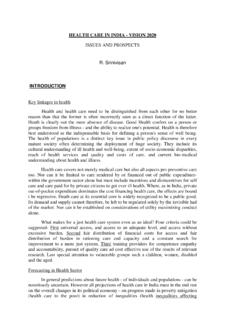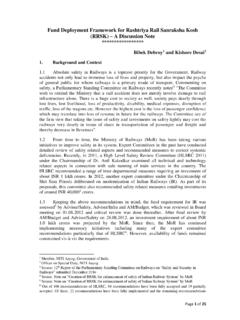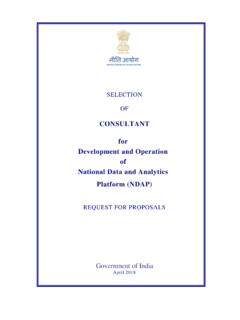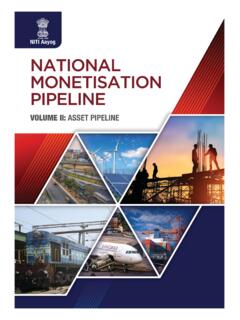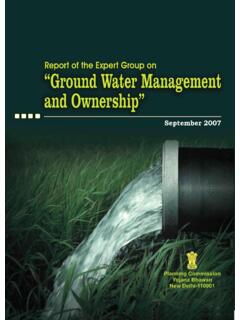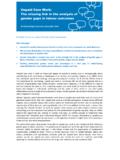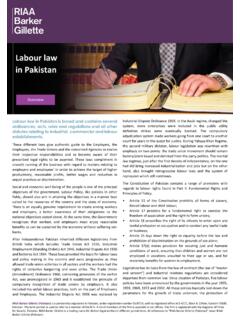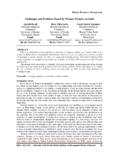Transcription of Current Employment and Unemployment Situation
1 Employment (VISION 2020). A significant change in inequality in income and wealth is possible only in a longer term perspective. Employment structure of an economy is the normal instrument that can cause a change in inequality either way, an increase or a decrease in the inequality. Other economic instruments such as target group policies and programmes have a short term impact, but the redistribution through Employment is sustainable. Since the governments function within the administrative and fiscal constraints, the target group programmes normally have a marginal impact on income redistribution. Income of labour enables flow of resources across income classes of people and across the social and ethnic groups. Flows of income across locations are influenced both by assets available and by other modes of creating Employment opportunities.
2 However, income generated by Employment of migrant labour , facilitates flow of resources across regions for a given regional distribution of capital assets. Employment and equity of income across classes of people and across regions are, therefore, closely related to each other in the long term. Current Employment and Unemployment Situation As noted earlier any vision of the future has to be rooted in the Current reality and policies and processes have to be identified to bridge the gap between the Current reality and the future vision. It is , therefore, essential to have an understanding of the broad Employment picture as it exists today, which would also indicate the directions for improvement in future. Some aspects of the Current Employment scenario are listed below.
3 % of the labour force , in the year 1999-2000, was unemployed. In absolute terms the number of unemployed stood at million. Since the above estimates are on Current Daily Status basis, the number of unemployed also includes the number of those who are underemployed in terms of underutilization of the labour time. But it excludes such underemployed who are working at very low levels of income and productivity. Among the employed, the proportion of poor is as high as in the population at large, suggesting a large proportion of workers engaged in subsistence Employment . Only about 8 % of the total Employment is in organized sector. More than 90 % are engaged in informal sector activities, which is, largely outside the reach of any social security benefits and also suffers from many 1.
4 Handicaps in form of limited access to institutional facilities and other support facilities. The educational and skill profile of the existing workforce is very poor. Factors determining the Employment Situation in the Long Term A. Supply of labour The factors, which influence Employment outcomes of an economy in the long term, operate both on the demand side of the labour as well as on the demand side. The supply side factors which need to be considered include the following. Age structure of population. The participation of population in labour force ; and Characteristics of labour force . Age Structure of population The size of economically active population is determined by the age structure. Population growth will reduce from the Current level (1991-2001) of per cent per annum to about per cent by 2020.
5 Growth of population in the working age group (15 to 59) is at present around per cent, substantially higher than growth of overall population. This will continue to be so for many years. Convergence between growth of population and that in the age group 15-59 years occurs around the year 2030. Since labour force participation is not uniform across age groups, the size of labour force is influenced by age structure. participation in labour force the labour force participation rate (LFPR) is influenced by need to work versus other alternative uses of one's time. A unidirectional relationship between growth of population and labour force has not been observed in the past (Table 1). Table 1: Growth of Population & labour force 1972-73 to 1999-2000. (per cent per annum).
6 ---------------------------------------- ---------------------------------------- ------------------------ Period Rate of Growth Rate of Growth of Population of labour force (UPSS). ---------------------------------------- ---------------------------------------- ------------------------ 1972-73 to 1977-78 1977-78 to 1983 1983 to 1987-88 1987-88 to 1993-94 (1983 to 1993-94) ( ) ( ). 1993-94 to 1999-2000 2. ---------------------------------------- ---------------------------------------- -------------------------- The question is whether the observed deceleration in the labour force growth would continue into the future. It could be so if it has been caused by a structural change in the economy. Some decline in labour force growth could be due to a lower growth in population, which also implies a slower growth in working age population.
7 However, the decline in labour force growth from per annum to between 1983/1993-94. and 1993-94/1999-2000 is too sharp to be explained by deceleration in population growth alone. Deceleration in population growth during this period has to be seen together with the decline in labour force participation Rates (LFPRs) for a possible explanation. labour force participation The decline in participation rates observed during 1993-94 to 1999-2000 needs to be carefully examined in terms of trends in different segments of the population and by different age groups and in a longer-term perspective. participation rates thrown up by various rounds of National Sample Surveys during 1983 to 1993-94 are given in Annexure-1. It can be seen that the decline in participation rates across age groups, in most of the cases, either fit into a longer term trend or changes are not very significant.
8 The decline in the LFPR in the younger age group reflects longer term trend of shift in activity status of this group towards education. This trend is likely to continue in future. Similarly, in the age group 60 and above the decline in the LFPR can be explained by increase in the share of more aged in the 60 and above population, where the LFPRs are expected to be low. In a few cases the declines are sharper and the reasons need to be looked into. In this background, the future projections of labour force in relation to working age population have to be considered. The participation rates for younger age groups have dropped much more than other age groups (Table 2). In the 10-14 years age group, the decline will be to near zero in the next 5 to 8 years as elementary education becomes compulsory.
9 Table 2: labour force participation Rates * for Rural Male in 1999-2000 relative to 1983. Age group LFPR 1999-2000. LFPR 1983. 10-14 15-19 20-24 25-29 All ages * UPSS Basis 3. A countervailing factor to prevail in the long run is the reduction in differentials between male and female labour force participation rates. In the past 17 years, female /. male LFPR differential has increased. (Table 3) However, some increase of LFPR. (Female) relative to LFPR (Male) was observed in the decade 1983 to 1993-94. In the States having high per capita income, the female / male LFPR ratio is higher. In the older age groups, the female to male LFPR differential is less than those in the younger (reproductive) age groups. During the next 20 years as the average age of female labour force increases, the female-male LFPR differential should reduce.
10 It is also seen that as per capita income levels rise, the gap between male-female LFPRs reduces after touching a bottom level. That is when the excess supply of labour reduces and labour demand- supply gaps begin to emerge. Recent studies done in the Planning Commission place the labour force growth in next ten years at % In the subsequent 10 years period, the labour force growth should be around to This implies, on an average , an annual addition of approximately 7 million persons in the labour force . Table 3:Ratio of Female to Male labour force participation Rates*. Age Group Rural (R) / 1983 1993-94 1999-2000. Urban (R). R 20 - 24. U R 24 - 29. U R 30 - 34. U R 40 44. U R 50 - 54. U R All Age Groups U * Usual Status Basis labour force skills Income of labour its wage level is determined by productivity.



